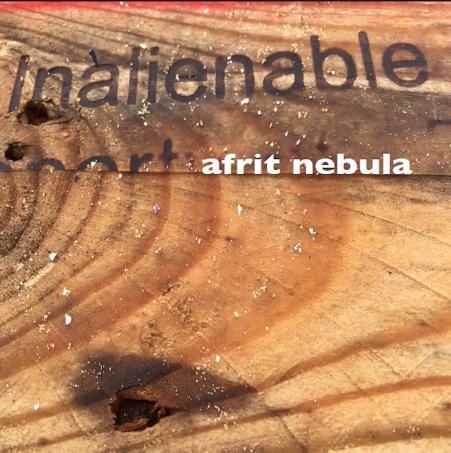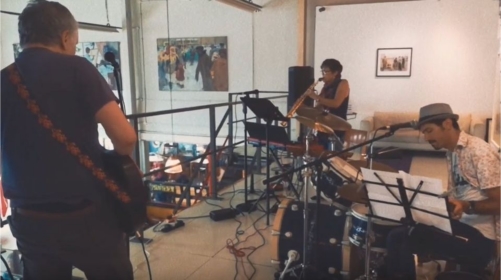
|
«« culturecourt |
|
AFRIT NEBULA: |
|
Paul A. Green [Bro Paul] |
AFRIT is a powerful demon in Arabian myths. NEBULA is an interstellar cloud of dust. Brother Paul explores the possibilities of ‘post-modern jazz’ demonstrated by this adventurous UK trio. The Afrit File Inalienable is Afrit Nebula’s third release, after Triality in 2018 and the EP Punkique in 2015. The band was formed in 2014 in St Leonards, East Sussex, part of the Hastings musical melting pot, by Ken Edwards (bass, vocals), Elaine Edwards (sax, flute, keyboards) and Jamie Harris (percussion and vocals). The group went underground during the pandemic. When it re-emerged, Jamie had moved on, to be replaced by drummer Yair Katz. Ken is a writer - I reviewed his novel Nostalgia For Unknown Cities in Culture Court when it came out in 2007- and also publisher of new fiction at Grand Iota. Elaine’s background is in musical education, while Yair has toured and recorded with numerous bands in New Zealand and works as a music therapist. As influences they cite Middle Eastern music, Japanese Kabuki theatre, Frank Zappa, John Coltrane, Xenakis and Steve Reich - an eclecticism which typifies the possibilities for the artist now as we swim through what the musicologist David Toop has called an ‘ocean of sound’ that floods over us from the cyber world, where music from every genre and period floats in a timeless present. Ken and Elaine’s previous band The Moors, which flourished from 2009 to 2018 also drew on a range of traditions - Balkan folk music with its complex time signatures, the skirl of Jewish klezmer, Cuban laments for Che Guevara and medieval Sephardic tunes, all electrified with guitar, fiddle and a big beat. ‘Best band in Hastings,’ said Plaza Mike, a fan of their many exuberant gigs in the pubs of Sussex and beyond. But diversity can also present a challenge when trying to discover a new musical identity and an audience that is open to experiencing unfamiliar forms and sonorities. However, as in their previous releases, Afrit have succeeded in fusing together different elements to create a distinctive presence. There’s deliberation in balancing rhythms and textures and structuring the clash of musical languages, while certain themes, both musical and conceptual, recur to create an overall unity. To call it a ‘concept album’, which carries overtones of hippies with Tarot cards, would be misleading. But the pieces allude to underlying preoccupations - philosophical concerns even - about what it is to exist as a human being in an increasingly post-human environment. |
|
| |
Inalienable Inalienable: ‘that which cannot be transferred to another or others e.g inalienable rights.’ Alienation, becoming alien, the mind alienated from itself - such anxieties and paradoxes are evoked in the title track, a surreal elegy for consciousness-as-we-know-it. A deep synthesizer drone is disrupted by frenetic drum breaks. A bass line emerges, pulsing slowly under mournful soprano saxophone and percussion that scratches and rustles like alien mandibles. A male voice tries to soothe the listener: Let the mind The chant is repeated under the keening cry of the soprano and the pulse of the bass which throbs like the slow theta wave of a brain in trance. The tempo quickens as a pentatonic piano riff dances over drumbeats before morphing into a free-form improvisation via call and response exchanges with the rhythm section. The increasing tension and fragmentation is punctuated by percussive chords and treble stabs as if the music is about to fly apart but the players, perhaps inspired by Ornette Coleman’s principle of ‘harmelodics’ are listening closely to each other, creating an overall unity. The soprano sax returns, fast and furious, swooping and trilling over the bass, wailing through the spaces opened up by Coltrane and Ornette. Then the rhythm section subsides and the melancholy sax motif resurfaces before a sombre piano coda. RIP Mind... |

Momentum/Time is Now/Tixerb Kufyeh These three tracks segue together. The first is a haunting two and half minutes. Ominous strumming bass and edgy percussion lurk under soprano sax. Elaine plays long plaintive whole notes, with eerie shifts of pitch, exploiting the eldritch quality of the instrument, using the bright slightly nasal tone favoured by post-Coltrane players rather than the buzzing vibrato of Sidney Bechet. The cry of the horn intensifies, then fades as we move into a very different musical territory. ‘The Time is Now’ might allude to the Charlie Parker classic ‘but it’s an instrumental reworking of a song from an earlier Moors album, and draws on those folk influences. The jaunty melody over a tricky rhythm, with interjections of whooping and whistling, evokes village wedding festivities somewhere in the Balkans .It’s followed by ‘Tixerb Kufyeh’ which loosely translates as ‘Hey, Fuk Brexit.’ Here the sax takes off into a wild improvisation, but always with that underlying minor-key pentatonic melancholy which is reinforced by a brooding bass solo and becomes darker as the piece progresses. Scrabblin’ With Scriabin Alexander Scriabin was one of the most ambitious and innovative Russian composers of the early twentieth century, a mystic influenced by Symbolism and Theosophy, who devised new scales and chords, anticipating the twelve tone compositions of Schoenberg and others. Afrit use one of these in this reflective piece which opens with the interplay of vibraphonic synth timbres and bass guitar, soon joined by percussion. A riff emerges, underpinning an enigmatic melody from the soprano sax, which leads to an exchange with Yair Katz’s alert response on the drum kit. (His drumming, which ranges from hypersensitive interpolation to full-on funk, is one of the strengths of the album.) The sax continues to a solo, following the discipline of Scriabin’s six-note scale which generates unexpected intervals and melodic variations, before the piece reverts to glacial keyboards. Kwaidan-AI This track, the longest on the album, evokes the alien nature of artificial intelligence and the conundrum of the ghost-in-the-machine as a model of consciousness. There’s also an implied reference to the idea of transferring human personality to a technological medium, the grail of mind-uploading enthusiastically endorsed by post-humanist gurus like Ray Kurzweil and Hans Moravec. Offset against this is an allusion to the tradition of the ghost story, specifically ‘Kwaidan' (literally ‘Ghost Stories’), old Japanese folk tales collected by Lafcadio Hearn around the turn of the twentieth century and dramatised superbly in Masaki Kobayashi’s 1964 film Kwaidan. The piece opens with a simple flute motif repeated over drums, like a robotic march for a spectral fife and drum band, or the insistent note of a Shakuhachi bamboo flute. The march directs us to a supermarket checkout where an ingratiating cyber-voice (voiced by a human) requests the customer to scan an item and touch the screen to start. The exhortation is repeated, reinforced by metallic chimes like the boot-up chords of a Mac or PC, which becomes a keyboard solo before the flute returns, now slow and haunting as percussion creates poltergeist rustling and rattling. This introduces a cryptic dialogue in stylised speech-song, inspired by Ken Edward’s actual interrogation of an AI bot. It grows increasingly bizarre, as if the AI processor is unable to cope with open-ended questions. This forces an abrupt transition to uptempo drums and driving bass behind jagged keyboard chords and runs, a barrage of metal jazz, a metal mind at the end of its tether... Exspira Machina (Steam Pumps) Machinery is also the inspiration here, but in a different context. Like the previous track it falls into several sections. The first part with keyboard riffing over bass and drums has echoes of Steve Reich in its use of deliberate hypnotic repetition and was devised to be performed live as a soundtrack to Mark French’s film of the same name, screened at Kino Teatr St Leonards in 2019 in connection with a Butoh dance performance by Yumino Seki. French’s film is a complex montage, in the spirit of Dziga Vertov's 1929 Man with a Movie Camera, deploying a range of techniques like multiple exposures and split screens in portraying the crankshafts, pistons and flywheels of a Sussex steam pumping station, now a museum attraction. The film can be seen as a memorial for a lost technology; and this elegiac strain is reflected in the second phase of the music when Afrit’s previous vocalist Jamie Harris begins a wordless lament over funereal chords and drum beats - before a return to the relentless pulse of the first section, which slowly fades. The World is Burning The final track, to be released as a single, is the most immediately accessible, with its lilting keyboard figure and lively dance beat. It’s also the most explicit in its lyrical content, reminding us that the world is burning away... From the Great Hall of the People Like all the tracks, with the exception of Exspiria Machina, it was recorded by James Stonehewer at Old Town Studios in Hastings, mostly ‘as live’, a set-up which favours the interpersonal chemistry of collective improvisation. Stonehewer gives the band a spacious production, resisting the common tendency to over-compress, allowing a wide dynamic range for the quieter moments while giving the more bravura sequences plenty of punch. Inalienable represents another stage in Afrit Nebula’s musical voyage. The challenge, as always, in any art form that subverts genre expectations, is reaching a planet with the right audience... ©Paul Green May 2022 *Check out PG's website: https://www.paulgreenwriter.co.uk/poetry/ »» |
Media Court | © 1998-2022 | Lawrence Russell